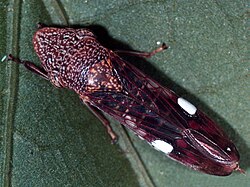
This is a list of diseases of grapes (Vitis spp.).

This is a list of diseases of grapes (Vitis spp.).

| Bacterial diseases | |
|---|---|
| Happy Disease (bacterial necrosis) | Xylophilus ampelinus = Xanthomonas ampelina |
| Crown gall | Agrobacterium tumefaciens |
| Pierce's Disease (PD) | Xylella fastidiosa |
| Bacterial inflorescence rot [1] | Pseudomonas syringae |




| Fungal diseases | |
|---|---|
| Alternaria rot | Alternaria alternata |
| Angular leaf scorch | Pseudopezicula tetraspora Contents |
| Angular leaf spot | Mycosphaerella angulata |
| Anthracnose and bird's-eye rot | Elsinoë ampelina |
| Armillaria root rot (shoestring root rot) | Armillaria mellea |
| Aspergillus rot | Aspergillus niger |
| Black rot of grapes | Guignardia bidwellii |
| Botrytis (Grey Rot or Noble Rot) | Botrytis cinerea |
| Bot canker | Lasiodiplodia theobromae Botryosphaeria rhodina (anamorph) |
| Ripe rot [2] | Colletotrichum acutatum species complex [3]
Colletotrichum gloeosporioides species complex [5]
|
| Miscellaneous diseases and disorders | |
|---|---|
| Berry rot | Yeasts |
| Black measles | Presumably toxins from wood-rotting fungi; see Wood rot (decay) |
| Chlorosis | Iron deficiency |
| Esca (Apoplexy) | Presumably toxins from wood-rotting fungi; see Wood rot (decay) |
| Fasciation | Genetic disorder |
| Little leaf | Zinc deficiency |
| Oxidant stipple | Ozone |
| Rupestris speckle | Physiological disorder |
| Stem necrosis (water berry, grape peduncle necrosis) | Physiological disorder |
| Nematodes, parasitic | |
|---|---|
| Citrus | |
| Dagger, American | |
| Dagger | Xiphinema spp. |
| Lesion | |
| Needle | Longidorus spp. |
| Pin | |
| Reniform | Rotylenchulus spp. |
| Ring | |
| Root-knot | Meloidogyne arenaria |
| Spiral | Helicotylenchus spp. |
| Stubby-root | |
| Stunt | Tylenchorhynchus spp. |
| Virus and viruslike diseases | |
|---|---|
| Alfalfa mosaic | Alfalfa mosaic virus |
| Arabis mosaic | Arabis mosaic virus |
| Artichoke Italian latent | Artichoke Italian latent virus |
| Asteroid mosaic | Undetermined, viruslike |
| Bois noir/black wood disease | Candidatus Phytoplasma solani |
| Bratislava mosaic | Bratislava mosaic virus |
| Broad bean wilt | Broad bean wilt virus |
| Corky bark | Grapevine virus B |
| Enation | Undetermined, viruslike |
| Fanleaf degeneration (infectious degeneration and decline) | Grapevine fanleaf virus |
| Flavescence dorée | MLO |
| Fleck (Marbrure) | Undetermined, viruslike |
| Grapevine Bulgarian latent | Grapevine Bulgarian latent virus |
| Grapevine chrome mosaic | Grapevine chrome mosaic virus |
| Grapevine red blotch | Grapevine red blotch-associated virus |
| Grapevine yellows | phytoplasma |
| Leafroll | Grapevine leafroll-associated viruses (Closteroviridae) |
| Peach rosette mosaic virus decline | Peach rosette mosaic virus |
| Petunia asteroid mosaic | Petunia asteroid mosaic virus |
| Raspberry ringspot | Raspberry ringspot virus |
| Rupestris stem pitting | Undetermined, viruslike |
| Shoot necrosis | Undetermined, viruslike |
| Sowbane mosaic | Sowbane mosaic virus |
| Strawberry latent ringspot | Strawberry latent ringspot virus |
| Tobacco mosaic | Tobacco mosaic virus |
| Tobacco necrosis | Tobacco necrosis virus |
| Tobacco ringspot virus decline | Tobacco ringspot virus |
| Tomato black ring | Tomato black ring virus |
| Tomato ringspot virus decline | Tomato ringspot virus |
| Vein mosaic | Undetermined, viruslike |
| Yellow speckle | Viroid |